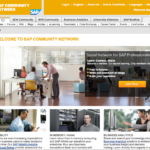One of the disadvantages of writing an article like 8 Bold Resolutions for Marketers is that you simply can’t go into detail on each of the topics covered. The 5th resolution, “I will carefully cultivate my customer community,” was based on my extensive interview (below) with Mark Yolton, SVP of Marketing at SAP. Mark is in charge of the extraordinarily successful SAP Community Network and not surprisingly, can and does make a great case why other marketers should cultivate their own customer communities.
DN: What do you think have been the keys to SAP’s success with the SCN to-date?
First, we began with a targeted audience and a focused mission: to help developers achieve success with SAP’s platforms and solutions. Only after we had critical mass in that audience did we expand to include a broader base, with the expansion of the target audience driven by the community itself, and features and functionality prioritized based on what our target community members wanted or needed. Essentially, we were pulled along by serving them, rather than pushing them into new directions we thought interesting, with the success of our community members always as our guide. Over time, we expended from the base of developers, to sysadmins and IT professionals more broadly, then to business process experts and project managers who straddle IT and lines of business, to business analysts and dashboard designers, and then to include university students and professors – all drawn by community member and market needs. We moved from basic discussion forums which were appropriate for basic Q&A, to longer-form blogs, to a wiki which is more flexible for projects and work groups… and included aspects of gamification, a career center with job board when the economy took a downturn, to an outside-in innovation crowdsourcing space. Constant evolution through monthly updates and larger advances, based on active listening and responsiveness to community feedback.
DN: What are the real advantages of having a user community?
The advantages depend on your vantage point…
Our individual members report that they are more productive, finding answers and solutions faster, and of higher quality, by being able to consult with other customer and partner members of the 2 million-plus SAP community. Individually, they elevate their expertise, and put it on display where the quality of ideas – rather than other factors – helps people rise to the top and get positive attention. Their careers accelerate, their professional horizons expand beyond their city, or country, or industry. On a more visceral level, there’s also an energy that comes with connectedness; members are energized by each other, the back-and-forth of interaction, the excitement and enthusiasm, and the feeling of being part of something bigger and more important than each of us individually … it’s a contagious excitement and an immeasurable but palpable sense of belonging and shared value.
Our SAP customer companies who have employees participating in the SAP community gain open access to subject matter experts for fast implementation and issue resolution so their projects are completed faster, and with higher quality, which helps them reduce their operations costs and total cost of operations. From the connectedness across industries and across global commerce, they are able to increase their business and technical knowledge and insight, make business connections within the vast SAP ecosystem to expand their market influence, and have an easier time discovering, evaluating, and accessing SAP and our partner solutions for more advanced implementations. They even have a greater ability to keep up with emerging trends, and to influence SAP and its ecosystem through participation and connections. And prospective customers in the solution evaluation cycle have the ability to interact with active SAP customers to get their unfettered feedback and advice – and to get a sense of the extraordinary value and unique benefit the SAP community provides.
SAP partners have the opportunity to establish themselves as subject matter experts, and to gain access to the entire global universe of more than 170,000 customer accounts in our installed base for more fine-tuned market insight as a way to focus their solution offerings, and to keep an eye out for sales opportunities. They can forge relationships with other SAP partners for solution co-development and joint go-to-market, and even post-sale they can call upon a wider set of experts to help speed problem resolution. We can also demonstrate SAP’s unusually strong commitment to the SAP partner ecosystem through all of these efforts, as well as our work and investments to generate and pass along leads to partners – it strengthens those partner ties with SAP and the value of partnering with SAP, so we gain more of the best partners to augment and extend SAP’s core.
For SAP as the host of the community, we gain faster adoption and ramp-up whenever we introduce new or upgraded products and services to the market, since our reach and influence are huge and immediate. As a company, we gain speed, agility, better decision making, and reduce our risk because we gain rich insights into what our customers really want and value, gleaned through our direct connections and fluid feedback loops and listening posts. We can improve product and solution quality through our customers’ direct outside-in feedback on our products, services, processes, and customer experiences. We reduce the cost, complexity, and time to provide core support while maintaining high quality – and can plow those savings back into better community mechanisms and product innovation. Those and other forms of interaction lead to higher customer satisfaction and loyalty, better customer retention, up-sell and cross-sell opportunities on the top line, and efficiencies through cost savings on the bottom line.
DN: Would it be as useful (to you or your members) if it wasn’t so large?
There’s a certain critical mass that needs to be built in order for a community to be vibrant, diverse, distributed, and valuable. If we had a very simple product or a homogenous market, we could deliver benefits with a small member base. But SAP is a global company, with a vast array of products and solutions, operating in nearly every country and territory on the planet, every industry, serving every aspect of global commerce. In order to serve our diverse market, we need a very large member base to gain access to experts in everything from Finance to HR lines of business, banking to mining to consumer-goods industries, in Europe and South America and Asia, and across every solution and sub-module of SAP’s portfolio. We hit the tipping point at about a million individual members several years ago, and we continue to grow at about 40,000 new members each month. Those kinds of member numbers give us depth and diversity of expertise in just about any relevant topic of interest to our SAP community.
DN: If you were advising a fellow CMO who was thinking of setting up a community today, what would tell him/her? Any shortcuts?
Without hesitation, I would advise any other CMO to lean forward and start building their community without delay, because the value far outweighs the cost, and it is the future. However, it’s not easy, simple, or inexpensive, and it’s not something that you can build, launch, and then let go. Community is part science – the platforms, plumbing, apps, and underlying infrastructure – and part art – the policies, practices, programs, and people-oriented components. It’s uncharted territory, so you’ll need to navigate areas of company rules, emerging legal precedents, daily new learnings, and plenty of antibodies. It’s not something that you can short-cut; authenticity and transparency and long-term relationships and commitments are key. Get an expert on board who has experience, form a core team to execute, and be personally involved.
DN: Lots of communities are started (like LinkedIn groups) but very few gain traction. Why do you think that is?
Communities take work over the long-term, and it’s clear that not everyone who starts one is expecting, anticipating, or willing to put in the time and effort to make them work. There are hunters and farmers, and communities require aspects of both … hunters to undertake and execute big but limited-time and scope projects, launch them, and move on … short bursts of energy, big pay-offs, motivated by the adrenaline rush of achievement and covering alot of new ground fast; farmers who will toil day-after-day, pruning, nudging, nurturing over the long-term… almost imperceptibly small moves but with staying power, persistence, and timeframes of months and years. I believe that some communities fail because they don’t take the longer-term view, expect results too fast, and don’t deliver enough value to their target audiences to warrant their members’ continued attention and deep engagement.
DN: How do you see communities evolving in the next few years?
The platforms and tools have evolved, now, to the point where almost anyone can participate; you don’t need to be a tech guru to participate. This means that for companies like SAP, we can move from technologist-based communities, to business-oriented communities, right on to communities of c-level members. We will see both public and private areas where open discussions can occur, whether shared with the world or with a select group of trusted members. We will see more companies hosting communities of their customers and partners, where those groups really set the agendas, guide the company to build products or to set standards that better suit the needs of the customers. We will come to expect, as consumers and customers, that the brands we do business with provide the benefits to us of online communities. And companies will see that the benefits of hosting customer communities will differentiate them, and then will be an expected way of doing business, with tremendous value to everyone who participates.


